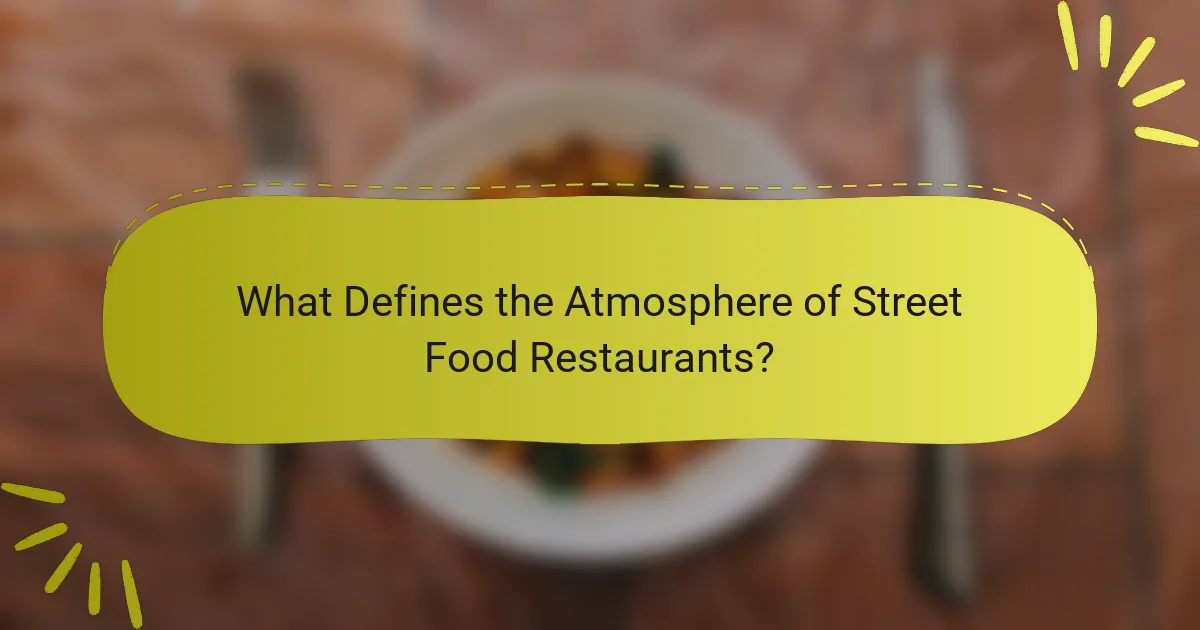The article explores the atmosphere of street food restaurants, focusing on key elements such as ambiance, music, and decor. It highlights how these components create a vibrant and casual dining environment that enhances customer satisfaction and engagement. The interplay of open-air seating, colorful decor, and the sounds and smells of diverse cuisines contributes to a dynamic experience. Additionally, the article examines how music influences emotions and social interactions, while decor reflects cultural identity and attracts specific demographics. Understanding these factors provides insights into consumer behavior and preferences in the street food dining context.

What Defines the Atmosphere of Street Food Restaurants?
The atmosphere of street food restaurants is defined by their vibrant and casual environment. This includes open-air seating and colorful decor that reflects local culture. The sounds of sizzling food and lively chatter contribute to a dynamic ambiance. Street food restaurants often feature music that enhances the dining experience. The smells of diverse cuisines create an inviting and appetizing atmosphere. Additionally, the interaction between vendors and customers fosters a sense of community. Overall, these elements combine to create a unique and engaging dining experience.
How do Ambiance, Music, and Decor Influence the Dining Experience?
Ambiance, music, and decor significantly influence the dining experience by shaping the overall atmosphere. Ambiance sets the mood and can evoke emotions, affecting how diners perceive their meal. Research shows that a well-designed ambiance can enhance customer satisfaction and encourage longer visits. Music plays a crucial role; studies indicate that the tempo and volume can alter diners’ eating pace and enjoyment levels. For instance, softer music tends to promote relaxation, while upbeat music can energize the dining experience. Decor contributes by creating visual appeal and thematic consistency, which can enhance the overall perception of quality. A cohesive decor style can make a restaurant feel more inviting and memorable. Collectively, these elements create an environment that can enhance or detract from the enjoyment of food.
What Elements Contribute to the Overall Ambiance of Street Food Restaurants?
The overall ambiance of street food restaurants is shaped by several key elements. These include vibrant decor, lighting, and seating arrangements. Colorful murals and signage often reflect local culture. Ambient lighting creates a welcoming atmosphere. Open seating encourages social interaction among diners. The presence of food stalls adds to the lively environment. The aroma of cooking food enhances the sensory experience. Music plays a crucial role in setting the mood. These elements collectively create an inviting and engaging dining experience.
How Does Lighting Affect the Atmosphere in Street Food Venues?
Lighting significantly influences the atmosphere in street food venues. It sets the mood and can enhance the dining experience. Bright lighting often creates a lively and energetic environment. Dim lighting can foster intimacy and relaxation. Different colors of light can evoke various emotional responses. For example, warm tones can make a space feel cozy. In contrast, cooler tones can create a more modern and clean atmosphere. Studies show that well-designed lighting can increase customer satisfaction. Effective lighting can also highlight food displays, making dishes more appealing. Overall, lighting plays a crucial role in shaping the overall vibe of street food venues.
Why is Music Important in Street Food Restaurants?
Music is important in street food restaurants because it enhances the dining experience. It creates an inviting atmosphere that encourages social interaction. Research shows that music can influence customer behavior, leading to longer visits and increased spending. A study published in the Journal of Consumer Research found that background music can enhance mood and satisfaction. This is crucial in street food settings, where the ambiance plays a significant role. Upbeat music can energize the environment, making it more appealing to customers. Additionally, music can reflect the cultural identity of the cuisine being served. This connection helps to create a memorable experience for diners.
What Types of Music are Commonly Played in Street Food Establishments?
Street food establishments commonly play upbeat and lively music genres. Popular choices include reggae, jazz, and pop music. These genres create a vibrant and inviting atmosphere. Research indicates that music influences consumer behavior positively. For instance, a study published in the Journal of Retailing found that upbeat music can enhance the dining experience. Additionally, local music reflecting cultural heritage is often played. This helps to create a connection with the cuisine offered. Overall, the music selection aims to enhance customer enjoyment and encourage longer stays.
How Does Music Selection Impact Customer Enjoyment?
Music selection significantly impacts customer enjoyment in street food restaurants. The right music enhances the dining experience by creating an inviting atmosphere. Research shows that upbeat music can increase the pace of eating and encourage longer stays. A study published in the Journal of Consumer Research found that congruent music styles with the restaurant theme improve customer satisfaction. Furthermore, music influences mood and can lead to increased spending. Customers often associate positive emotions with their dining experience when the music aligns with their preferences. Thus, careful music selection is crucial for enhancing overall enjoyment in street food settings.
What Role Does Decor Play in Shaping the Atmosphere?
Decor plays a critical role in shaping the atmosphere of street food restaurants. It influences customers’ perceptions and experiences. The choice of colors, materials, and furnishings can evoke specific emotions. For example, warm colors like red and orange stimulate appetite. Unique decor elements, such as local artwork, create a sense of place and authenticity.
Research indicates that well-designed decor can enhance customer satisfaction and encourage repeat visits. A study by Bitner (1992) highlights that physical environments significantly impact customer experiences in service settings. Therefore, effective decor contributes to a welcoming and enjoyable atmosphere, ultimately driving business success.
What Styles of Decor are Popular in Street Food Restaurants?
Industrial decor is popular in street food restaurants. This style features raw materials like metal, wood, and concrete. Exposed brick walls and open spaces are common in these settings. Vibrant colors and street art often enhance the atmosphere. Upcycled furniture is frequently used to create a casual vibe. Neon signs and casual seating arrangements add to the appeal. Many restaurants incorporate local cultural elements into their decor. This connection to the community makes the dining experience more authentic.
How Can Decor Reflect the Cultural Background of the Cuisine?
Decor can reflect the cultural background of the cuisine through the use of traditional motifs and materials. For example, a Mexican restaurant may feature vibrant colors and handcrafted pottery. These elements evoke the rich heritage of Mexican culture. Similarly, an Italian eatery might use rustic wooden tables and vintage wine bottles, representing Italy’s culinary traditions.
Cultural symbols, such as artwork or textiles, also enhance the dining experience. They create a visual narrative that connects diners to the cuisine’s origins. Incorporating local artifacts further deepens this connection.
The arrangement of decor can mirror cultural dining customs. For instance, communal seating reflects family-style dining practices common in many cultures. Ultimately, decor serves as a bridge, linking the aesthetic experience to the culinary journey.

How Do Ambiance, Music, and Decor Interact in Street Food Restaurants?
Ambiance, music, and decor in street food restaurants interact to create a cohesive dining experience. The ambiance sets the overall mood and atmosphere, influencing customer comfort and enjoyment. Music enhances this experience by affecting emotions and encouraging social interactions. Decor complements both elements by visually appealing to patrons and reinforcing the restaurant’s theme. For instance, vibrant colors and street art can evoke a lively, casual environment. Studies show that music tempo can influence dining duration and spending behavior. Together, these elements engage the senses, making the dining experience memorable and enjoyable.
What are the Synergistic Effects of Combining Ambiance, Music, and Decor?
The synergistic effects of combining ambiance, music, and decor enhance the overall dining experience. Together, they create a cohesive atmosphere that influences customer emotions and behaviors. A well-designed ambiance can increase comfort and relaxation. Music can evoke specific moods, making the experience more enjoyable. Decor elements contribute to visual appeal and cultural representation. Studies show that restaurants with harmonious ambiance, music, and decor see higher customer satisfaction. For instance, a study by North et al. (1999) found that background music affects dining duration and spending. This synergy not only attracts customers but also encourages repeat visits.
How Can a Cohesive Theme Enhance the Dining Experience?
A cohesive theme enhances the dining experience by creating a unified atmosphere. This unity can make customers feel more comfortable and engaged. For example, consistent decor, music, and menu design can evoke specific emotions. Research shows that ambiance significantly affects customer satisfaction and perceived value. A study by the Cornell University School of Hotel Administration found that a well-defined theme can lead to a 20% increase in customer retention. Additionally, a cohesive theme can facilitate storytelling, making the dining experience memorable. Overall, a cohesive theme contributes to an enjoyable and immersive dining environment.
What are Examples of Successful Atmosphere Integration in Street Food Venues?
Successful atmosphere integration in street food venues includes vibrant decor, engaging music, and open seating arrangements. For example, the food stalls at the Night Market in Taipei use colorful lights and local art to create an inviting ambiance. The food truck scene in Portland often features live music, enhancing the dining experience. Additionally, the Hawker Centers in Singapore incorporate communal tables, fostering a sense of community. These elements collectively attract customers and enhance their overall experience.

What Insights Can We Gain from Analyzing Street Food Restaurant Atmospheres?
Analyzing street food restaurant atmospheres provides insights into consumer behavior and preferences. The ambiance influences customer satisfaction and dining experience. Factors such as lighting, color schemes, and spatial layout play a significant role. Music selection can enhance mood and encourage longer stays. Decor elements reflect cultural identity and attract specific demographics. Studies show that a vibrant atmosphere can increase foot traffic and repeat visits. Understanding these dynamics helps businesses tailor their offerings to meet customer expectations.
How Can Restaurant Owners Optimize Atmosphere for Better Customer Engagement?
Restaurant owners can optimize atmosphere for better customer engagement by focusing on key elements like lighting, music, and decor. Warm lighting creates a welcoming environment, enhancing customer comfort. Background music should match the restaurant’s theme and energy, influencing customer mood positively. Unique decor can reflect the restaurant’s identity, making it memorable for patrons. Comfortable seating arrangements encourage longer stays, leading to increased spending. Additionally, cleanliness and organization contribute to a positive atmosphere. Studies show that a well-optimized ambiance can increase customer satisfaction and repeat visits.
What Practical Tips Can Enhance Ambiance, Music, and Decor?
To enhance ambiance, music, and decor in street food restaurants, focus on cohesive themes. Choose decor that reflects the cuisine’s cultural background. Use warm lighting to create a welcoming atmosphere. Incorporate comfortable seating arrangements for social interactions. Select background music that complements the dining experience. Ensure volume levels allow for conversation. Use aromatic elements, like spices, to engage the senses. Regularly update decor to keep the environment fresh and inviting. These strategies collectively improve the overall dining experience and attract customers.
What Trends are Emerging in the Atmosphere of Street Food Restaurants?
Emerging trends in the atmosphere of street food restaurants include vibrant decor, interactive dining experiences, and the use of technology. Many establishments are adopting colorful, eclectic designs to create an inviting ambiance. Interactive elements, such as open kitchens, allow customers to observe food preparation. Additionally, technology integration is becoming common, with digital menus and contactless payment options enhancing convenience. Sustainability is also a focus, with eco-friendly materials in decor and packaging. These trends reflect a shift towards a more engaging and responsible dining environment.
How are Technology and Innovation Shaping Future Street Food Experiences?
Technology and innovation are transforming future street food experiences through enhanced convenience and personalization. Mobile apps facilitate easy ordering and payment, streamlining customer interactions. Smart food trucks utilize GPS for optimal location tracking, attracting more customers. Augmented reality menus provide an interactive dining experience, allowing customers to visualize dishes before ordering. Contactless payment systems improve hygiene and speed of service, especially post-pandemic. Social media platforms enable vendors to engage with customers and showcase their offerings effectively. Data analytics help vendors understand customer preferences, tailoring menus accordingly. These advancements are reshaping how consumers experience street food, making it more accessible and enjoyable.
The main entity of the article is the atmosphere of street food restaurants, characterized by vibrant ambiance, music, and decor. The article explores how these elements interact to create an engaging dining experience, highlighting the significance of ambiance in shaping customer perceptions and satisfaction. It discusses the impact of music on mood and behavior, as well as the role of decor in reflecting cultural identity and enhancing visual appeal. Additionally, the article examines emerging trends and technological innovations that are transforming the street food experience, providing insights for restaurant owners to optimize their atmosphere for better customer engagement.